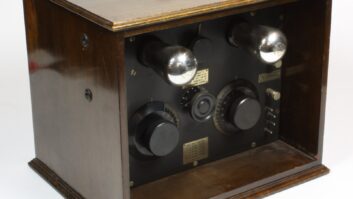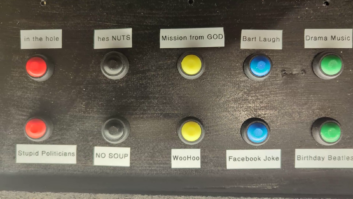Internet radio is enjoying a rocky reality. Despite its potential for interactive, on-demand access, few portals have achieved audience reach that comes close to conventional, over-the-air outlets.
“The secret of our success,” says Brad Chambers, chief creative officer and founder of MartiniInTheMorning.com, “is that we have created a unique presence that serves a targeted community.

Brad Chambers. ‘We are a radio station created in the image of those great community radio stations.’ Mel Lambert|content-creators.com “Rather than positioning ourselves as just a radio station or a website, Martini is a ‘new standard’ for our listeners’ lifestyle, where we feature the greatest songs ever written delivered in a variety of audio formats for iPhone, BlackBerry or Droid handheld devices, Nokia smart phones and Windows Media-equipped smart phones.”
Established four years ago by Standard Media Group, “MITM” operates from studios in North Hollywood, Calif., delivering MP3-, WMA-, Flash- and AAC-format streams at a variety of data rates.
Staff includes Executive Assistant Miriam Garfield, Merchandising Manager Heidi Streif, Technical Manager Al “The Engineer” Taddeo and IT Manager Jeff Morrison, plus on-air personalities/announcers, Harry Young, John Van Kamp, Kitty Collins and Rod West.
Beyond nostalgia
“Martini is about a lifestyle that encourages travel, dining out, cocktails and contribution to the community through various charities,” Chambers said.
“The station plays contemporary adult standards. But we are not era-specific nor nostalgia-based; our material can come from any decade. We look for artists that offer unique interpretations of contemporary classics that were popularized by the likes of Frank Sinatra, Dean Martin and Sammy Davis Jr., for example, and other from those key ’40s, ’50s and ’60s decades.”
On one recent day, the site featured the likes of Jamie Cullum, Jane Monheit, Michael Buble and Diana Krall as well as Sammy, Dean and Frank. “Our criteria are song, artist and production/performance. Anything that meets two of those three will be on our playlist.
“For example, Eric Clapton and B.B. King singing ‘Come Rain or Come Shine’ or Rod Stewart singing ‘Someone to Watch Over Me’ — we are just as likely to play interpretations of classic songs by such people as Harry Connick Jr. and other current artists than the originals.
“In other words, we are not playing up nostalgia for that ‘Rat Pack Era,’ because our playlist is new music for much of our audience. It is, after all, the most American of music.”
Chambers worked for nine years with Clear Channel as director of programming distribution and technology and PD/morning personality with KLAC(AM) in Los Angeles; he was at Jacor/Clear Channel in Boise, Idaho, as regional operations director, and Clear Channel, as director of programming distribution and technology based in in Covington, Ky. He also has worked with Dame Media at WRBT(FM) in Harrisburg, Pa.; Imprint Records in Nashville; and Susquehanna Radio/KPLX(FM) in Dallas.
“The average age of a Martini listener is 49,” Chambers said, with 55–64 as the next largest segment, followed by 35–44.
“This is a good demographic, since it represents a group of people that is interested in music which pre-dates their childhood and reflects a lifestyle choice. And our targeted community is international, not just local; we have regular listeners in Europe, Africa and Asia.
“Unlike most Internet radio stations,” he continued, “MartiniInTheMorning.com is no jukebox — a string of songs, one after another.
“We are a radio station created in the image of those great community radio stations. And our community is not defined by a city limit, county line or by the signal limitations of the radio transmitter. It is defined by a lifestyle, a passion for the music we play and an ability to come together and be a part of something bigger than itself.
“The station sets itself apart from the Internet by being a real radio station with personalities, contests, even commercials, avoided by some stations in favor of listener subscriptions and other such financial models. We separate ourselves from our broadcast cousins by limiting commercial content.”
Currently, the portal carries up to four minutes of commercials per hour.
Arguing that syndicated radio remains a viable proposition, Chambers plans to offer the MITM format free-of-charge to HD Radio multicast channels.
“The future of radio lies on the Internet,” he said. “But HD Radio could survive with the right content; listeners are not interested in recycled content [from over-the-air channels], or heavily automated formats being offered as an alternative. Real-time, interactive programming will win out every time. HD is viable if there is something worth listening to.
“Radio has always been a one-way process,” Chambers offers. “At Martini, we aim to make it two-way, through listener participation on our highly interactive website, and via remotes. We also see that listener passion is an advertiser benefit, and a differentiation from our immediate competition.”
Video too
MITM’s signal path starts at a Wheatstone D-75 digital console that handles mic sources and outputs from a Prophet Systems rig that stores digitized music cuts, PSAs and station liners.
“The console’s analog outputs connect to an Orban Optimod-PC 1101 PCI audio card that is housed in the streaming PC,” said Technical Manager Al Taddeo. “I use a light-compression preset — ‘Greg Open’ — which gently tightens up the station’s deliverables without sounding heavily processed.
“The MP3 and related streams are created by our SOS commercial-insertion system, while the AAC-plus and Flash streams are generated by an [Orban] Opticodec-PC 1010 application” offering output rates of 32 and 64 kilobits per secone. The Flash-compatible media facilitates an “FM quality” stream that carries pre-launch video commercials, while a 96 kHz stream is intended for UStream listeners.
A separate audio-video stream with an in-studio webcam carries a separate 96 kHz Flash-format stream. “MartiniVision accounts for maybe 20 percent of our listeners,” Chambers says. “They are very vocal when it goes down.” MP3 and WMA streams are at 64 kbps.
The portal cites an average audience approaching 600,000 total monthly listening hours.
“We need between 1.25 and 1.5 million listening hours per month to make money,” Chambers says with a wry smile. “Our community is growing, but not fast enough to become competitive with commercial, broadcast radio.

“Currently, 10 percent of our audience is mobile, listening in the main on [Apple] iPhones in their cars and SUVs. The iPhone has completely changed our listening potential, and is growing rapidly. As more automobiles are made available with in-dash Internet radio, we see this number increasing even more quickly.
“We are also looking at developing a custom app for the iPhone that will also enable us to capture listener metrics, which is problematic at the moment with no standard reporting process. National accounts — which is where our core revenue will come — look for local as well as wide coverage. Our streaming mechanism [and region-specific advertising insertion software] will let us handle that requirement. We can also develop local text messaging for our UStream material. But we remain in the top 2–3 percent of individual Internet radio stations.
“North America is our core audience, and one that attracts national advertising; the foreign coverage is a bonus and good entertainment for our U.S. and Canadian listeners. We surprised a lot of our audience the other day by reading out a weather forecast for Nairobi, Kenya.”
Responding to the inevitable rainbow question of what three wishes he would like to see granted for Martini in the Morning, Chambers pauses and takes a deep breath.
“First, we could use a benevolent investor,” he replies. “And then a liquor sponsor, to support our lifestyle trajectory. And, thirdly, an even playing field for Internet radio, so that it can compete with conventional radio and satellite delivery. Currently, our per-use music fees are under threat and we are prevented from playing complete albums.
“MartiniInTheMorning.com is the soundtrack for a lifestyle,” Chambers concludes, “and for a community that might appear to have little in common. But when they turn on the radio or browse their personal music library, or participate in a walk-a-thon to fight breast cancer, it turns out there is much that brings them together as a community.”
Mel Lambert says he has been involved with production and broadcast industries on both sides of the Atlantic for more years than he cares to remember. He is principal of Media&Marketing, a Los Angeles-based consulting service for the professional audio industry. Reach him at[email protected].












